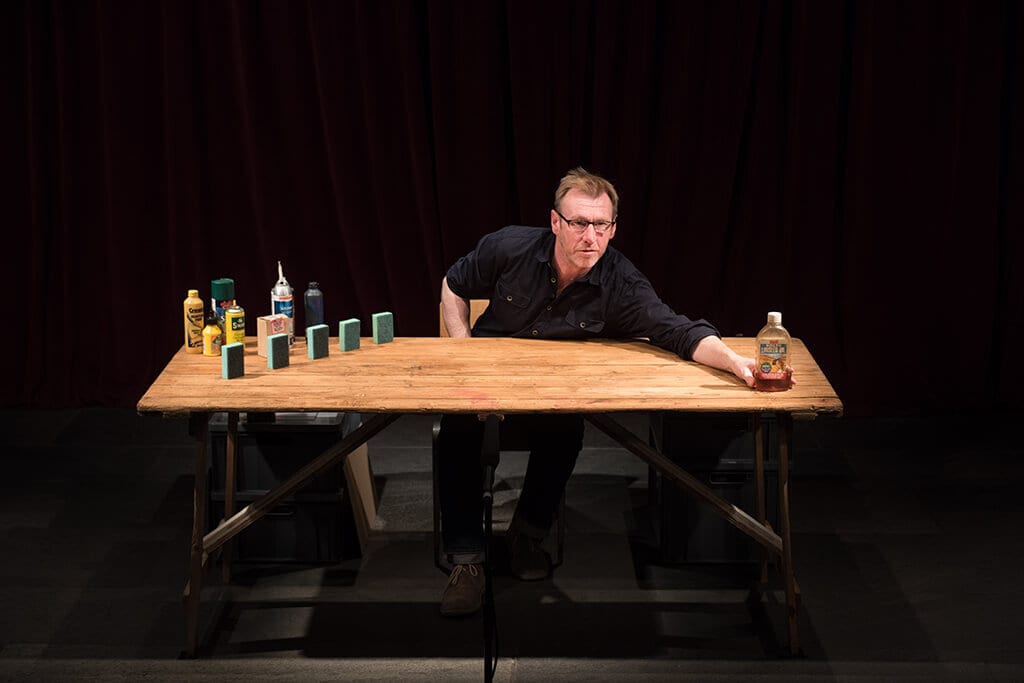I remember many moons ago my particularly imaginative English teacher explained the entire plot of The Merchant of Venice to me and my classmates in about 5 minutes, using only staplers, board pens and sellotape as characters. She made it seem simple, interesting and accessible.
Upon hearing that I was to review a performance of effectively the same thing at the Barbican – Shakespeare’s works retold using tabletop condiments – I was a little dubious. I understood the sentiment: to condense all of Shakespeare’s often daunting plays into hour-long amuse-bouches, focussing on the complexities of plot only, rather than language, to wet people’s appetite for the Bard without being too difficult. I assumed that the main aim was to prove to audiences that there was more to Shakespeare than the iambic pentameter and metaphysical soliloquies he is famed for, but would it work?
As the focus was on plot, I challenged myself to see two sets of plot sequences, one which I knew very well, and one which I knew less well: Richard II and Henry IV (I) (II) respectively. These two histories are very different. Richard II is largely a very serious play where there is little action apart from one event (Richard’s ultimate deposition), and so the play centres around Shakespeare’s masterly ability to build Richard’s character and ask difficult philosophical questions of the audience. Henry IV Part I and II both involve more action, featuring battle and more geographical changes, as well as being much less serious, with many critics claiming the bumbling Sir John Falstaff is one of the greatest comic characters in the history of theatre.
Richard II was unfortunately a little disappointing in its seriousness. It’s only when you see the play distilled into its pure plot, with no verse, as Forced Entertainment have done, that you realise how little actually happens in Richard II. All the moving and striking parts of the original are lost: Richard is no longer a complex character, the abandoned tyrant, but a skinny vinegar bottle that moves around complaining. His speeches are not there to make you question the nature of power and respect, and even simple and comical moments like the Duke of York’s unabashed shame over his son’s treason, are not featured. Unfortunately, with all this simplification, the audience are just left clutching at the dull patterns of Shakespeare’s stripped wallpaper. Dry and dated.
The delivery of Richard II didn’t help much either. No amount of slow, hushed recitation can make ‘They all leave’ whilst handling vinegar and whisky bottles seem atmospheric. Nothing was made in the performance, apart from the occasional pause at the audience’s titters when seeing mustard bottles, of the unusual fact that they are using household items to tell canonical stories. The narration was exactly the same as if the props weren’t there, and apart from perhaps the significance of choosing Henry Bolingbroke’s avatar to be a fine Scotch whisky, it all felt a little gratuitous and irrelevant.
Henry IV was much more enjoyable. The delivery was not as slow and serious, and more was made of the household items used to tell the story, such as using a dilapidated washing up bottle to portray Henry’s ageing self. The light-hearted nature of omitting complex verse and simplifying the plays into storylines also fitted better with Henry IV’s more comical content.
However, the main reason the later performances were an improvement was purely because I didn’t know Henry IV as well as Richard II. If you know the plot of the play, that is all the performance is, and it can feel a little like being teacher’s pet in GCSE English revision classes. Henry IV’s plot was more surprising and enthusing to me purely because I hadn’t heard it all before.

